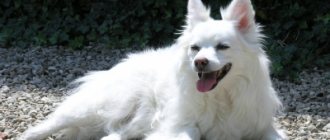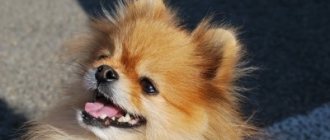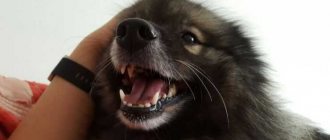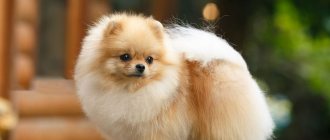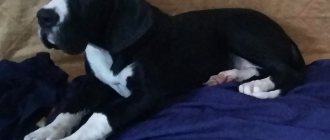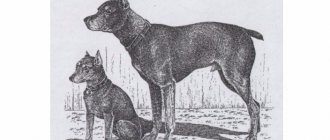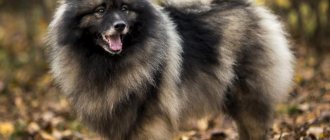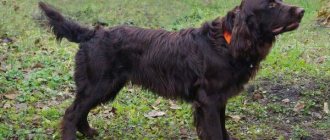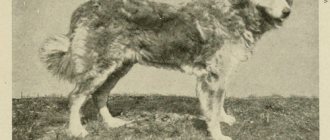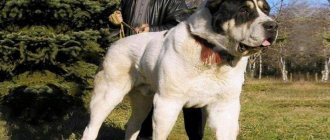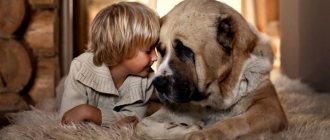History of the origin of the breed
Miniature Spitz are the smallest of all Spitz breeds. Their ancestors lived back in the Middle Ages in Germany and were called German Spitz or Pomeranians (an outdated name from the Pomerania region).
Miniature Spitz are the smallest of all Spitz breeds.
What is the difference between a Miniature Spitz and a Pomeranian? Nothing, these are two different names for the same breed.
Interesting information - the word “Zwerg” means gnomes, small human-like creatures, hence the name “Zwergspitz”.
In 1870, in England, Queen Victoria brought with her from Venice small Spitz dogs, which she liked. She had two favorites - Marco and Turi. The second became so attached to his mistress that he accompanied her on her last journey on her deathbed.
In the British Empire, work began on the creation of dwarf Spitz, known throughout the world as miniature Spitz. They tried to give them sophistication, beauty and attractiveness by reducing their size. English breeders succeeded! Dwarf Spitz dogs are popular everywhere; their exterior attracts attention and leaves no one indifferent.
But to this day there are debates - are small German Spitz and miniature Spitz or Pomeranians the same breed? A more preferable option is varieties of the same breed.
A little history
The first mentions of the German Spitz can be found during the Middle Ages. The dog received its second name “Pomeranian” thanks to the country from which the breed spread throughout the world. The first representatives of the dwarf dog breed were bred in Pomerania, and now Germany. Therefore, the dog can be called either one way or another - both options will be correct. The breed gained its true popularity after puppies appeared in England in the 19th century. Queen Victoria brought them there, taking the babies from Italy.
The ancestors of the miniature spitz used to reach a large weight category, namely, they weighed 15 kg; the size of the animal allowed it to be used as a herding breed. By selecting the animal with other breeds, breeders were able to obtain a miniature dog with high decorative characteristics.
In 1871, Miniature Spitz received the status of an officially recognized breed. Two decades later, they developed a standard by which the characteristics of the animal are compared with other representatives of German Spitz: Pomeranians, Kleinspitz. In America, the country's kennel club recognized the Miniature Spitz relatively recently, in the 20th century.
At the moment, the decorative characteristics of the dog allow the animal to be used only for domestic keeping, bringing visual pleasure to the owner. The miniature size of the Miniature Spitz does not allow them to perform other functions, despite their keen hearing and loud, ringing bark. The cute appearance of the dogs does not fit in with the arrogant and self-confident character of the animal. Dwarf Spitz dogs need training.
The Miniature Spitz was first mentioned in the Middle Ages. It received its second name “Pomeranian” due to the region of distribution. It was in Pomerania (the territory of modern Germany) that the first representatives of the dwarf Spitz breed appeared. That's why some experts call it a German Spitz, and some call it a Pomeranian.
READ White cat breed with different eyes
The breed became popular after Queen Victoria of England brought puppies from Italy in the 19th century.
Looking at the photo of this tiny creature, it’s hard to believe that its ancestors weighed 15 kg, and their size made it possible to use dogs as shepherds. But it was from such ancestors that the modern miniature spitz originated, which was bred by crossing the smallest representatives of the original breed.
In 1870, representatives of this breed were officially recognized, but only twenty years later a standard was developed that the dog must meet. A description of the requirements that a dog must meet can be found online on the websites of cynological associations.
The breed was recognized by the American Kennel Club only at the beginning of the last century.
Modern realities are such that the Miniature Spitz is positioned as a decorative miniature breed, the task of which is to bring visual pleasure to its owners. The German Miniature Spitz does not perform any other functions due to its tiny growth. Although, given the presence of acute hearing and a loud bark, the dog can easily become a watchman and serve as a house bell.
But you shouldn’t hope that the miniature spitz, whose photo is simply mesmerizing with its cartoonishness, will unquestioningly play the role of a home toy. This is an overly self-confident person who requires an appropriate attitude. Representatives of this breed love to learn and are easy to train.
Miniature Spitz breed standards
These dogs were officially recognized at the end of the 19th century, but by American dog handlers only at the beginning of the 20th century.
Appearance
Miniatures look like German Spitz dogs, except for the head structure. The muzzle is slightly flat, with a convex forehead and small ears that are not visible due to the fur. The coat is also slightly different - the miniature has a longer, soft coat with undercoat, unlike its “German” counterpart.
Typical puppy
The tail is straight, but there are exceptions with slight curls.
Height
Up to 20 cm in height.
Weight
Weight about 3 kg.
Color
The gallery presents various photo options of Miniature Spitz:
- black-brown;
Cute black and brown spitz
- grey;
Gray Spitz on a walk
- white color;
White Spitz family
- orange;
The penetrating eyes of the Pomeranian
- cream;
Cream Spitz
- chocolate.
Chocolate Miniature Spitz
Lifespan
Dogs live 12-16 years.
Character
The Spitz's character is soft, playful, cheerful and kind. These merry fellows always make their neighbors happy, running and jumping around carefree. They become strongly attached to their owner (example Queen Victoria), do not know life without him and become reliable friends to everyone around their owner.
They are good-natured with children, they can play and spend time with them.
Leave this sweet little bundle of kindness alone with your child - nothing bad will happen.
The miniature needs constant training of mind and body. Dog handlers advise playing with him more and giving him various commands to keep him in good shape.
Despite its small size, the dog needs daily exercise
Flaws
First of all, they bark for no reason. This barking cannot be stopped. If you start to show aggression, it will increase in duration.
Secondly, they are completely unaware of their size. German Miniature Spitz attacks other dogs, even if the latter are much larger than them. Just keep her away from other large dogs and keep your Pomeranian under control. Remember, this should not irritate, but rather flatter, because the little protector is ready to do anything for the sake of his owner.
German Miniature Spitz (Pomeranian)
| German Miniature Spitz (Pomeranian) |
| Contacts: Krasnoyarsk, (391) 21-48-77 |
— Current FCI standard for German Spitz, No. 97/05.03.1998 (in English, taken from the official FCI website)
— FCI standard for German Spitz (in Russian)
Our boys
| Char`S Real Gold Art Party | ||
| Father: Finch`sn Char`s Parti Fudge Mother: Char`s Ramblin Rose Party Titles: | Breeder: Charlotte Mayer Owner: Elfimova A. Contacts: Krasnoyarsk, tel. 8-913-189-28-34 |
| Delicious Duck Magister | ||
| Father: YuChR,ChR Pom City Lavrik Mother: YuChR,ChR Tsefera Teffi Dlja Delishes Titles: YuChNKP, YuChR, RKF, Yun. Champ. Sloven, Yun. Champ. Europe 2010, ChNKP, Champion of Cyprus, Macedonia, Montenegro, Moldova, Rum, Bol, Georgia, Balkan countries, Russian Champion, Grand Champion | Breeder: Sukhomlinova I.A., Owner: Udekul E.A. Contacts: Zheleznogorsk, tel.8-913-529-90-15 |
| Delicious Art Encore Dark Soul | ||
| Father: Lord Brown of Colored Drop Mother: Delicious Pretty Sue Titles: | Breeder: Sukhomlinova I.A., Owner: Udekul E.A. Contacts: Zheleznogorsk, tel.8-913-529-90-15 |
| Kamis Zeus of Olympus | ||
| Father: CR Classic Act Mother: Quest For The Best of Little Gangsters Paradise Titles: | Breeder: Susekova E., Owner: Voloshina Yu. Contacts: Krasnoyarsk |
| Secretdogs Rokki | ||
| Father: Sunterra Sweet Dream Mother: Patch of Sunlight Aquarblle Titles: YUCHR, CR, CHNKP, RKF, Grand | Breeder: Khromova M. Owner: Samsonova M. Contacts: Achinsk, tel. 8-902-945-14-50 |
Our girls
| Charm Revenge Gift of Destiny | ||
| Father: Champion Grand, Ros, RKF, ChK - House Mouse from Tsvetnaya Drop Mother: Russian Champion - Nation New Age Titles: YUCHR, CR, CHNKP, CHRKF, Grand Champion | Breeder: Reshchikova E. V. Owner: Reshchikova E. V. Contacts: Krasnoyarsk, tel. 8-902-916-62-32 |
| Georgette Zlata Lota | ||
| Father: Kalo`s Awesome Mini Mike Mother: Manon Milissa Titles: Yun Champion Ros, YuChNKP | Breeder: Ignatyeva Owner: Kovaleva Nina Contacts: Krasnoyarsk, tel. |
| Valencia Goges From Cascade of Dreams | ||
| Father: Charlie Vanilla from Cascade of Dreams Mother: Casino Of Kou Ju Tsai Pet Store Titles: ex. | Breeder: Maksimova Owner: Elfimova A. Contacts: Krasnoyarsk, tel. 8-913-189-28-34 |
| Almy Yurnis Paula Silva | ||
| Father: Bravo*S Tom Thumb Parti Mother: Spectrum Line Arctic Frost Titles: CAC, Champion of Khakassia | Breeder: Bogdanova N. Owner: Elfimova A. Contacts: Krasnoyarsk, tel. 8-913-189-28-34 |
| Grand of Ruza Fanny | ||
| Father: Bravo's Wild Child Mother: Spectrum Line Arctic Frost Titles: | Breeder: Emelyanova L. Owner: Elfimova A. Contacts: Krasnoyarsk, tel. 8-913-189-28-34 |
| Krasnoyarsk Princess Kamila | ||
| Father: Young Champion Ros, CR - Velvet Oof Mother: Angel of My Soul Titles: | Breeder: Derevianko N. Owner: Derevianko N. Contacts: Krasnoyarsk, tel. 8-905-971-30-25 |
| Romantic Sweet Vanilla | ||
| Father: Grand Champion, ChRKF - Secretdogs Rocky Mother: Grand Champion, RKF Yeladuga Siberian Beauty Titles: Champion Ball, Grand Champion Ball, Room, Champion Room, Macedonia, Montenegro, Georgia, Cyprus, Moldova, Balkan countries, Black Sea Winner | Breeder: Podlesnaya Yu. Owner: Podlesnaya Yu. Contacts: Krasnoyarsk, tel. 8-902-945-97-90 |
| Siberian Sissy Eva Supermodel | ||
| Father: YuChR, YuChNKP - Sirelis Universal Pictures Mother: Dan-Star-Com Charming Pampered Girl Titles: | Breeder: Kakaulina I. Owner: Lebedeva E.N. Contacts: Krasnoyarsk, tel. |
| Rus House Voorhut Justina | ||
| Father: Puff Pie from Russian Court Mother: Toy Triumph Iris Titles: | Breeder: Gelya Owner: Grinina Contacts: Krasnoyarsk, tel. 8-902-91-333-70 |
| Secretdogs Penelope | ||
| Father: CR Suntera Sweet Dream Mother: CR Patch of Sunlight Watercolor Titles: | Breeder: Khromova N. Owner: Derevianko Contacts: Krasnoyarsk, tel. 8-905-971-30-25 |
| Tiffany Replica | ||
| Father: Secretdogs Rocky Mother: Krasnoyarsk Princess Camilla Titles: | Breeder: Derevianko Owner: Sizova Contacts: Krasnoyarsk, tel. 8-905-971-30-25 |
| Happiness Axiom Germanica | ||
| Father: Velvet Oof Mother: Roshi Pearl Bead Titles: | Breeder: Parnyakova E. Owner: Kozlova E. Contacts: Krasnoyarsk, |
Content
Since Miniature Spitz dogs are decorative dogs, their care is more thorough and demanding.
Care and hygiene
Pomeranians have very beautiful, soft fur. To avoid various pellets and tangles, comb the pile with a special comb. In Spitz dogs, shedding occurs once a year in males, twice a year in females. They shed gradually, almost imperceptibly, so notice them in time and comb your pet every day.
Beautiful and soft wool
Don't wash your miniature often. Clean your ears and trim your nails once a month. Correct his haircut if necessary.
Nutrition and diet
The health of a Spitz primarily depends on its diet. Feed your dog both natural products and dry food.
List of natural products that benefit the zwerg:
- meat without fat - beef, fillet and breast of poultry, beef or poultry heart and liver;
- boiled eggs - two a day, no more;
- porridge - everything except pearl barley and millet are poorly absorbed in the body;
- vegetables and fruits - except potatoes and legumes;
- fish - do not feed raw fish, it will cause worms;
- fermented milk products - do not give raw milk, it is not absorbed in the body.
To maintain your dog's health, you should follow a diet
List of prohibited products:
- flour products;
- seasonings, spices, sweets;
- potato;
- fat meat;
- legumes;
- bones;
- any food with preservatives;
- any fatty food.
To make feeding your pet easier, use premium and super-premium dry food. These foods contain everything a pet needs for a long and healthy life - the active elements and vitamins that a dog needs.
If you want to combine food and food, you cannot do this in one meal. Give dry food in the morning, meat or fish for lunch, and something light in the evening, for example, just cottage cheese.
Mixing food and food in one meal is not recommended.
Dog handlers recommend the following diet: feed the puppy 6 times a day for up to two months, and reduce the meals as they grow older. And so on until two meals a day, when the puppy reaches eight months.
Serve food at specific times to get your pet accustomed to a feeding routine.
Diseases, breed defects
Miniatures are not without diseases. In order to find and eradicate the disease in your pet’s body in a timely manner, examine it more often.
List of the most common diseases:
- Hypoglycemia. Low body weight puppies experience seizures. This is due to rapid metabolism and reduced glucose levels. To avoid the progression of the disease, simply feed the puppy more often.
- There are several reasons for bad breath. Tartar or gastric dysfunction. If this occurs, contact a specialist immediately.
- Eye diseases. Tearing, cataracts, entropion and retinal atrophy.
- Patella. At its core, it is a dislocation of the kneecap.
- Alopecia X or “black skin” disease. This problem does not bother most people, but if the miniature has it, consult a specialist.
- Cough and tracheal problems. Cough occurs when overexcited or even during normal play. Pay close attention to a wheezing cough - this is a sure sign of tracheal collapse. If found, contact your veterinarian immediately.
To avoid illness in your pet, conduct regular examinations.
Miniatures are not free from breed diseases:
- Cryptorchidism. A testicle or even two at once did not descend into the scrotum.
- Epilepsy. Hereditary disease. Manifested by seizures.
- DTS (hip dysplasia). A common problem for all purebred dogs.
- Hernia. Due to the structure, it can occur in the navel or groin.
Nutrition
The diet of miniature spitzes must be properly structured; it is this that affects the health of the pet. An adult dog can be fed using one of three methods:
- dry food;
- natural nutrition;
- combined method (natural food and dry food).
READ Mastopathy in cats causes, symptoms and treatment
For animals, only premium or super-premium food is purchased. Preference is given to food designed specifically for Spitz or toy breeds. Such products contain ideally balanced nutrients and minerals and contain essential vitamins. Popular food brands: Eukanuba, Natural, Acana, Husse and others.
Some owners soak dry food in water in advance. These actions are acceptable, but the food must be diluted in such a proportion that the dog eats it in one sitting. Anything left over should be thrown away. Leftover pieces of food quickly deteriorate and can negatively affect your pet’s health.
Natural food is food not from the owner’s table, but prepared products. Animals will benefit from eating the following foods.
- Lean meats. It can be beef, poultry, beef or chicken liver, heart.
- Give your pet a boiled egg once a day.
- Boiled porridges made from cereals are recommended, with the exception of pearl barley, millet, and semolina. These cereals cause bloating and colic due to poor digestion by the dog’s body.
- The diet includes fruits and vegetables. Potatoes and legumes should not be given.
- The use of fish and seafood is acceptable. Any fish is served boiled, without bones.
- Fermented milk products must be pasteurized. No raw milk.
It is prohibited to feed the animal the following products:
- confectionery products, various buns, baked goods, sweets, any flour products;
- spices, seasonings;
- food with preservatives;
- salted, smoked, pickled, fatty products;
- sausages.
You cannot change the animal’s diet suddenly or frequently. Dietary changes should occur smoothly; within one week it is recommended to introduce or change one type of product. With a combined type of nutrition, natural food and dry food are not consumed at one meal. The diet is structured as follows. In the morning, the animal is given dry food and clean water. For lunch, the pet consumes boiled lean meat or fish products. In the evening he receives a fermented milk product, for example, cottage cheese.
The animal does not need a variety of dishes; one brand of dry food, two types of meat or fish, two or one types of cereals and a couple of vegetables will be enough. The animal must not be overfed. It is necessary to decide on the norm of food consumed and give your pet the same amount of food all the time. The frequency of meals can be divided into larger quantities, but the mass of food consumed should remain the same. Experts recommend the following picture of food consumption. Puppies up to two months eat 6 times a day. From two months - 5 times. From 6 months - 3-4 times. Over 8 months, the animal eats 2-3 times a day, most often the dog is fed in the morning and evening. It is advisable to feed your pet at the same hours.
The animals are very smart and easy to train. Training dogs is a mandatory procedure, otherwise the pet’s character may deteriorate. It is recommended to adhere to the following rules.
- The first stages of puppy training include simple permission commands. Babies are allowed everything that is allowed to an adult dog.
- It is prohibited to use any physical punishment or raising your voice.
- Commands are given clearly, clearly, and in an assertive manner.
- During the training process, the animal should be petted, praised, and supported in doing the right thing with tasty treats.
- Any required reaction from the pet must be encouraged.
- Miniature Spitz dogs can be trained to use the litter box, just like cats.
Training begins as soon as the animal gets home. Newspapers or other rags should be laid out on the floor. A tray is placed in the places where the pet relieved itself. To get used to the toilet, a piece of marked newspaper must remain in the tray, which is replaced with new ones over time. After a week, the toilet is cleaned and washed. The tray is gradually moved to the place where it will be permanently located. The toilet should be moved 10-20 cm after each toilet. During the period when the puppy gets used to the toilet, the animal can be placed in the tray after waking up or eating.
It is recommended to observe your pet's behavior. If the dog is circling and sniffing the floor, it must be taken to the litter box. After going to the toilet, the animal should be rewarded with a treat. If the puppy did not have time to get to the toilet or missed while doing its business, under no circumstances should you shout or punish the pet. The area is washed and treated with any chemical with a pungent odor. When the animal enters puberty and begins to mark corners, it is recommended to place a plastic bottle filled with any substance in the tray so that it does not tip over. Thus, the pet’s desire to mark its territory will be reduced to a trip to the bottle.
Family life
The Miniature Spitz will fit in well in a family; he is a kind fellow, attached to his owner and loving him with all his little dog heart. By bringing a Spitz into your family, you get not only a cute decorative dog, but a whole faithful companion who serves faithfully for many years.
The dog quickly becomes attached to its owner and gets along well with the family.
He is affectionate with children, does not bite and does not show aggression. Be careful with large pets in the house, he may mistake them for enemies and begin to defend the territory. Spitz are very smart little guys, they don’t bark at guests if you explain to them that these are strangers. When he understands this, he will begin to merrily jump around a gathering of people, attracting admiring glances.
Education and training
Miniature Pomeranians are very smart animals. Training and training will not take much time and effort. Follow a few basic rules, and your Spitz will become a role model in terms of obedience:
- Do not raise your voice at the dog or hit it.
- Speak clearly, clearly and assertively.
- Praise your pet every time he completes a task.
- Don’t skimp on rewards; the dog expects that he will be given a prize for a correctly performed action.
- Give a lot of time, care and affection (otherwise, the pet will become aggressive and begin to damage furniture to attract attention).
Miniature Spitz are very smart, training them will not take much time.
Pomeranian Spitz are overflowing with vitality, in addition, they have a sharp mind. Try to exercise your dog more often: at home, on a walk, in any free time - the pet will only be happy about it.
Even though a Spitz is a pet and is more comfortable at home with its owner than outside, still walk it twice a day to keep your pet in good shape.
Advantages and disadvantages
Like all dogs, Spitz dogs have both positive and negative aspects. The advantages of a dog include:
- Zwerg is a smart dog that easily accepts training and education.
- Cheerful and good-natured - you won't get bored with them.
- Active, play with children without offending them.
- Good health with proper care.
- Compact size, does not take up much space in the house.
The dog requires a lot of attention.
Disadvantages of Miniature Spitz:
- Regular and meticulous care.
- Requires a lot of attention.
- Frequent barking.
- Uncontrolled aggression towards other dogs while walking.
If you get yourself such a cute companion, you will forget about his disadvantages and find something of your own in this little bundle of fluffy happiness.
How to buy a miniature spitz
What to look for when purchasing:
You can buy a puppy in specialized nurseries or from private breeders
- Buy only from private breeders or a specialized nursery. If you take it by hand or in an unofficial place, they can deceive you by slipping in a sick puppy, a cross breed, or even a mongrel dog.
- Evaluate the place where you are getting the puppy from.
- Pay attention to the description of the pedigree, study it. If there are parents nearby, look at them, their behavior, appearance.
- Look how many puppies are in the litter, if more than 3, then buy.
- The puppies are active, with normal coat.
- Ask for vaccination certificates and passports.
Price
The price of a puppy rises for various reasons. But the main factor is where to get the puppy. The nursery is more expensive than a private breeder, since the breed standard must be met. The following points play a role:
The main criterion for determining the price is where the puppy was purchased
- Exterior.
- Size. The smaller the puppy, the more expensive it is.
- Pedigree.
- Litter quality.
- Puppy class.
- Age. Puppies are more expensive than adults.
- Floor. A girl costs more.
The average price for such a puppy ranges from 35 to 45 thousand rubles. This is a standard class of pet that does not stand out among other miniature spitz dogs. There are also other classes of dogs, but they usually cost three times as much as they participate in special exhibitions and competitions.
Where to buy and for how much?
The price of representatives of this breed depends on many factors. Firstly, the price depends on the size. The smaller the individual, the higher the price. Secondly, the price depends on the color. The more unusual the color, the higher the price. Lastly, the price depends on where you buy it.
A puppy purchased from a nursery is more expensive, but there is a 100% guarantee that the breed standard will be met. You can buy a puppy secondhand, which is much cheaper. But you need to be prepared for the breed standard to be violated. Moreover, where the standard will be violated - too much weight or height - the owner will only find out as the puppy grows up.
You can avoid misunderstandings if you purchase a Spitz from a nursery. Moreover, you should first read the description of the standard and look at the photos of the parents. After all, you can't argue with genetics.
READ Family species and habitats of sturgeon
